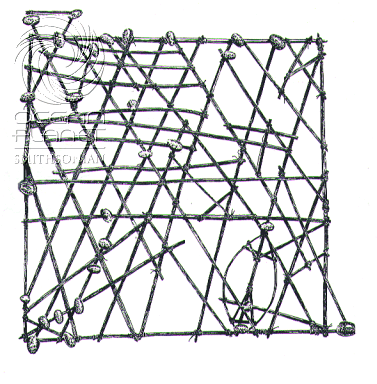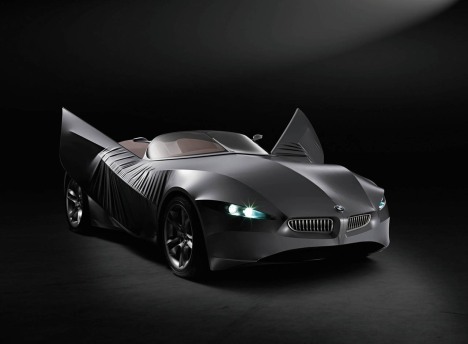Here is a link to an article from the Chronicle of Higher Education regarding a recent cardboard chair design competition. (The one my dad sent me!)
http://chronicle.com/blogPost/With-CardboardGlue/7456/
And another with the link to my delicious.com collection of artists who walk
http://delicious.com/katy.asher/walking
Friday, July 31, 2009
Thursday, July 30, 2009
David Altmejd
Marshall Island Navigation Stick Chart


This is a post for Katrina, who is trying to make a 3-d map of Portland's streets out of cardboard.
Your project reminded me of some Navigation charts I saw in the book You Are Here by Katharine Harmon made by people living and boating in the Pacific islands. It's my understanding that these charts show the waves and swells around certain islands (pictured here as shells).
Tuesday, July 28, 2009
Sculpture as props
Kinda sad, but the 20th Century Prop house in North Hollywood is going out of business and selling all its inventory. Besides the simple things like chairs, they have tons of sculptures - from Egyptian gods to the Lady Liberty used in Spiderman 3. I am not an LA fan, but I would love to be there right now - I can tell I would bid on a few things just to have some really unique stuff that is part of film history. (this warehouse has been in business for many, many years - just think of the items it can have!)
(You can view what was up for auction today as well as what is up over the next few days at http://www.greatamerican.com/GAGAuction/Auctions/AuctionDetails.aspx?Id=393)



I don't know what the dog is from but its a pretty cool sculpture - as is the HUGE hat!

(You can view what was up for auction today as well as what is up over the next few days at http://www.greatamerican.com/GAGAuction/Auctions/AuctionDetails.aspx?Id=393)


These remind of of the movie Stargate.

I don't know what the dog is from but its a pretty cool sculpture - as is the HUGE hat!

Oliver Van Der Lugt
Saw these cardboard installations on OK Great today.
They are by Oliver Van Der Lugt



his portfolio is here
-nicole
They are by Oliver Van Der Lugt



his portfolio is here
-nicole
Content and Form, Positive/Negative Space, Static and Dynamic Forms
Content the subject matter of a work of art or what the piece of art is supposed to be. If the work of art is not a representation of anything and serves no purpose other than being art, then content is simply a description of the piece of art.
Form consists of the physical characteristics of any work of art. For example, the materials used to create it, the shapes or lines seen in the piece or the finishes of the materials used or even the feelings expressed in the art.


Here are two images of a sculpture called Ridon by Ross Lovegrove. The content of this sculpture could be described as a flowing organic form inspired by a motorcycle rider. The form of the sculpture includes that it is made out of carbon fiber, has a polished natural carbon fiber finish and uses rounded shapes and lines without any breaks in the figure.

This is a photo of a concept car designed by BMW called GINA, which stands for Geometry and function in "N" Adaptations. The content of it is obviously a car. The form includes that it is made out of a dynamic articulating aluminum frame covered with a metallic looking flexible and stretchable fabric that allows the car to change shape. The flowing shapes used for body panels and the sharp angular lines where each one of these shapes meet also make up the form of this piece. Here is a link to a video that includes clips of the changing shape of this concept car:
BMW GINA
The concept of positive and negative space is the idea that shapes can be either made out of a solid material that fills a space or can be the space that is not filled with a material but defined and bordered by material.

Positive and negative space can be easily seen in this aluminum sculpture called The Big Cheese by Bruce Grey. Solid aluminum makes up the positive space and the spherical shapes representing holes in the cheese make up the negative space. You can see how the negative space/shape is defined using an absence of material, in this case aluminum.

The Pegasus wheel designed by Volvo Cars is one of my all time favorite design studies because of its overly simple design that still manages to be aesthetically appealing. In this image of it you can clearly see how the positive space of the wheel itself defines the negative shapes that fill the inside of the wheel.
In sculpture, static form means that the piece does not move or change form, where as dynamic form means that the work can either move or change shape or both. The GINA concept car from BMW seen above is a great example of a design piece with dynamic form.

Le Penseur, translated to English as The Thinker, by Auguste Rodin made out of bronze and marble is a good example of a static sculpture.
Since the essence of a dynamic work of art is movement, I decided that a static photograph simply wouldn't cut it, so here is a link to a video of a "working" sculpture used by Honda as a car commercial:
Honda Accord Commercial
Monday, July 27, 2009
Grid and Matrix
The grid pattern is created by a series of intersecting lines that create a checkerboard pattern. Grids divides a 2D surface into a series of continuous cells that can then be individuated or used to form a framework for patterning.

Ex Arsenale at Maddalena by Stefano Boeri Achitetti

Ladderstile House by ThreeFoldArchitects
A matrix is a three dimmensional grid pattern.

Quoted from http://www.flickr.com/photos/14779500@N07/2431442165

Ex Arsenale at Maddalena by Stefano Boeri Achitetti

Ladderstile House by ThreeFoldArchitects
A matrix is a three dimmensional grid pattern.

Quoted from http://www.flickr.com/photos/14779500@N07/2431442165
Repetition & Rhythm
Repetition, the recurrent use of a visual elements in one composition, is used frequently and to great effect in design. Reoccurring forms create a pattern or visual steam of connection in each of these compositions, forming a type of rhythm in each work.

Repetition by Ingrid Siliakus, 2004
Quoted from http://bit.ly/yqC7I

Repetition can be quite successfully used to create a sense of rhythm in design.

Bodegas Protos winery by Rogers Stirk Harbour + Partners
House in Matsuyama by Suppose Design Office

Repetition by Ingrid Siliakus, 2004
Quoted from http://bit.ly/yqC7I

Repetition can be quite successfully used to create a sense of rhythm in design.

Bodegas Protos winery by Rogers Stirk Harbour + Partners
House in Matsuyama by Suppose Design Office
RACC and the Dragons in Chinatown
Prior to our public art tour, Erica mentioned the story of the controversy surrounding some dragon heads that were installed in Chinatown back in 2007.
I did a little web research and offer the following links in case any of you might want to know more:
2007 RACC press release regarding removal of sculptures
2006 Mercury article discussing the sculptures
I did a little web research and offer the following links in case any of you might want to know more:
2007 RACC press release regarding removal of sculptures
2006 Mercury article discussing the sculptures
Pop Art
Pop Art is a movement that originated in Britain and the United States during the 1950's and 60's, partially due to the boom of post-World War II consumerism. As a reaction to more traditional art, pop art poses the notion that mass-produced visuals can be considered 'fine art' as well. Pop art borrows a lot of ideas, themes, and methods from advertising, comics, consumer products, and everyday objects that might otherwise have been considered 'boring.' Pop art takes these objects and materials out of their places in everyday life and isolates them, often times causing viewers to contemplate and/or appreciate them differently (this is an extension of Dadaism). Because of this, pop art is about the attitudes/connotations of a work of art, rather than to the actual art itself.
Valerie Hegarty, American
Niagara Falls, 2007
Marisol Escobar, 1930, French
Women and Dog, 1964
Magrite III, 1998
Eduardo Paolozzi, 1924-2005, Scottish
Michelangelo's 'David', 1987
Dress
Newton, 1995
Robert Rauschenberg, 1925-2008, American
Monogram, 1959
First Landing Jump, 1961
BMW 635 CSi, 1986
Claes Oldenburg, 1929, Swedish/American
Soft Light Switches, 1969
Giant Soft Drum Set, 1967
Dropped Cone, 2001
Subscribe to:
Comments (Atom)




































